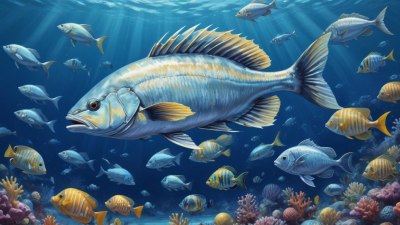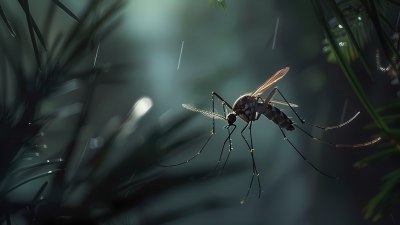The Connection Between Weather and Fish Behavior
Explore how weather patterns influence fish behavior and fishing success.

This image was created with the assistance of Freepik
Understanding the connection between weather and fish behavior is crucial for anglers and marine biologists alike. Fish are ectothermic animals, meaning their body temperature is regulated by the environment. Consequently, their behavior is significantly influenced by fluctuations in weather conditions. Variations in temperature, barometric pressure, and water clarity can all affect fish activity, feeding patterns, and overall movement. In this article, we will explore how different weather patterns impact fish behavior, providing insights that can enhance fishing success and contribute to better ecologic understanding.
The Role of Temperature
Temperature is one of the most critical factors affecting fish behavior. Fish exhibit specific temperature preferences that vary by species. Generally, most fish thrive in a particular temperature range. For instance, warm-water species like bass and catfish are more active in temperatures above 70°F (21°C), while cold-water species like trout prefer temperatures below 68°F (20°C). When temperatures fluctuate, fish tend to seek out areas that provide a more suitable environment. During sudden temperature drops, fish often retreat to deeper water where the temperature is more stable.
Impact of Barometric Pressure
Barometric pressure, the weight of the air above the earth's surface, significantly impacts fish behavior. Fish are sensitive to changes in pressure, much like humans can feel shifts in the air before a storm. Low pressure typically signifies an approaching storm, leading to increased fish activity as they prepare for feeding opportunities before the weather turns. On the other hand, high-pressure systems often cause fish to become lethargic, resulting in less activity. Understanding these pressure changes can help anglers know when to fish, as the hours leading up to a storm can provide prime fishing conditions.
How Seasonal Changes Affect Fish
Different seasons bring about distinct changes in fish behavior. During spring, fish tend to spawn, leading to heightened activity levels. As water temperatures rise, fish begin to feed aggressively, which can create excellent fishing conditions. In summer, however, high water temperatures may push fish to seek deeper or cooler areas, leading to changes in fishing techniques required to catch them. Autumn marks a feeding frenzy as fish prepare for winter, leading to significant movement and increased catch rates. Winter brings about hibernation-like behavior in some species, making them less active and harder to catch.
Weather Fronts and Fish Activity
Weather fronts significantly influence fish activity. A cold front typically causes a rapid temperature drop, which can lead to decreased fish activity due to discomfort. Conversely, warm fronts can produce more favorable conditions for feeding. The transition periods during these fronts can create some of the best fishing opportunities, as fish tend to feed before and after the front moves through. This behavior can be exploited by anglers who understand how to time their fishing trips around these natural phenomena.
Cloud Cover and Fishing Success
Cloud cover also plays a notable role in fish behavior. Overcast days often lead to increased fish activity, as fish feel more comfortable venturing out to feed when they are not exposed to bright sunlight. The lack of sunlight can encourage fish to forage closer to the surface, increasing chances for anglers to catch them. Conversely, sunny days might drive fish to seek shelter in deeper waters or under vegetation. Anglers can often take advantage of overcast conditions to enhance their chances of a successful catch.
Wind Influence on Fishing Conditions
Wind can impact fishing conditions by stirring up water surfaces, which can increase feeding activity. Wind can also cause fish to move toward calmer waters, where they feel more secure. Anglers often find that fishing on windy days can yield excellent results, as the wind creates currents that can disturb baitfish, enticing larger fish to come out and feed. However, strong winds can make it difficult to cast effectively, so understanding how to adjust fishing techniques based on wind conditions is crucial.
Rain and Fish Behavior
Rain can have both positive and negative effects on fish behavior. Light rain often improves fishing conditions, as it can increase insect hatches and cause fish to become more active. Increased water flow from rainfall can also dislodge food sources, creating opportunities for feeding. However, heavy rain may muddy waters and lower visibility, causing fish to retreat to better-oxygenated areas or seek shelter, making them harder to catch. Knowing how rain affects local fish populations is vital for targeting them effectively during different weather scenarios.
Water Clarity and Light Penetration
Weather not only influences the behavior of fish but also affects the clarity of the water in which they live. Heavy rainfall can introduce sediment and debris into the water, reducing visibility. Cloudy water can impact fish's ability to hunt effectively, driving them to deeper, clearer areas. Conversely, in clear water conditions, fish may become more cautious and less likely to bite. Understanding how to fish in different water clarity conditions is essential for maximizing success, as it directly relates to fish behavior.
Seasonal Behavior Changes
As seasons change, so too does fish behavior. In spring, spawning rituals drive fish to shallow waters, resulting in increased activity. Summer often sees fish move deeper to escape the heat, whereas autumn triggers a feeding binge as they prepare for colder months. Winter can drastically slow fish metabolism, and as a result, anglers need to adjust their techniques to target these lethargic fish. Recognizing the seasonal patterns allows anglers to plan trips around peak activity periods for their targeted species.
The Interaction Between Species
Different fish species exhibit varying behaviors based on environmental conditions. Predator-prey relationships can dictate fishing success, as the activity of one species often influences the behavior of another. For example, if baitfish are concentrated in a specific area due to favorable conditions, predatory fish will likely follow suit, offering anglers a chance to catch them. Understanding interspecies dynamics and how they correlate with weather conditions can provide insights into better fishing strategies.
Recognizing the connection between weather and fish behavior can greatly enhance an angler's success and ecological understanding. Variations in temperature, barometric pressure, and water clarity all dictate the movements and feeding patterns of fish. By tailoring fishing strategies to align with these environmental factors, anglers can improve their chances of landing a great catch. It is essential to monitor local weather patterns and observe how they impact fish behavior, as these insights play a critical role in successful fishing experiences. As we continue to study the intricacies of aquatic life, we deepen our appreciation for the complex relationship between weather and fish behavior, paving the way for more sustainable and effective fishing practices.











